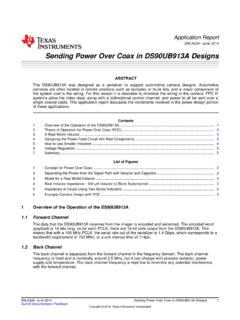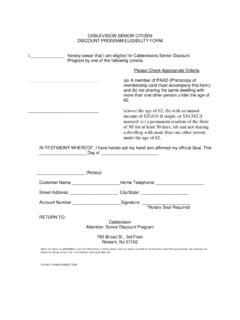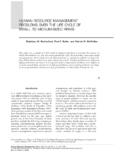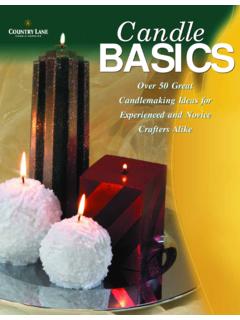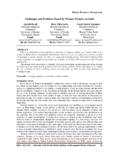Transcription of Mechanics of the Bent Over Barbell Row - …
1 Mechanics of the bent over Barbell Row By Tracy Anderson This is an excellent overall back building exercise. bent over Barbell rows will build a thick, strong back, if done correctly. The key is correct form, and many, atleast from what I see, don t know the correct way to perform this exercise. So lets look at correct form first, then we will get into the Mechanics of the exercise. Proper Form To perform this exercise grasp the bar with a wide over hand grip. The closer your hands are, the more your arm muscles will come into play, so your grip should be wider than your shoulders. After you have the bar firmly gripped, bend your knees slightly and bend over , while keeping your back straight, until your trunk is flexed between 45-65 degrees. Pull the bar to your mid section (mid-stomach to lower chest).
2 Lower the bar until your arms are fully extended and shoulders are stretched forward. This exercise is a basic compound, pulling movement and you can use heavier weight. You would do this exercise at the beginning of your back routine, while your smaller stabilizing muscles are not fatigued. Remember for your back to be isolated, your shoulders have to be depressed, back straight and chest up, and your arms relaxed. Joint Motions: The primary joint of involvement is the shoulder girdle, more specifically the glenohumeral joint (shoulder joint), acromioclavicular joint (AC joint) and movement of the scapula (shoulder blade). The primary bones involved are the humerus (upper arm bone) and scapula. The humerus will articulate with the glenoid fossa of the scapula on a frontal axis in the sagittal plane. The humerus will be abducted only slightly, about 35-60 degrees.
3 The higher the degree of abduction, the more upper back will be emphasized. If you relax while performing the movement, the elbows will follow the correct plane of motion, and you won t have to worry about the degree of abduction. Muscular Action The primary focus of the bent over Barbell row is to work the back in general. The back muscles will work together (synergistically) to accomplish this type of movement. The primary movers are the middle and lower trapezius, rhomboids, latissimus dorsi, teres major, posterior deltoid and the infraspinatus and teres minor. With assisting muscular action from the brachialis, brachioradialis, and the sternal portion of the pectoralis major. Dynamic stabilization s is performed by the biceps and the long head of the triceps. Dynamic stabilizers are biarticulate muscles that simultaneously shorten at the target joint and lengthen at the adjacent joint with no appreciable difference in length.
4 The erector spinae, hamstrings, gluteus, adductor magnus and abdominals will act as neutralizers to stop unwanted motion of the hips and trunk. The rhomboids and middle traps will retract the scapula, while the lower traps rotate the scapula upward. If performed correctly, with the shoulders down, and not shrugged, the upper traps will assist at best. The latissimus dorsi (lat) will perform the grunt of the work, with Muscle involved in bent rows. * Middle and lower trapezius * rhomboids * latissimus dorsi * teres major * posterior deltoid * infraspinatus and teres minor contribution from the teres major, in shoulder extension and hyperextension, as the upper arm (humerus) extends and should go behind the rib cage. Remember extension of the arm is coming from 180 degrees of flexion back to the zero degree mark, and hyperextension is going beyond the zero degree mark.
5 The posterior deltoid functions during extension and hyperextension. The teres minor and infraspinatus will contribute slightly with the action of horizontal abduction. Assistance and stabilization will come from the muscles of the arm. This exercise places a lot of stress on the lower back and should be avoided if you have lower back problems, or feel discomfort during this exercise. Make sure to stretch the muscles between sets, and don t forget to stretch your lower back and hamstrings. A good back routine might begin with 4 sets of this exercise and then you could do 4 sets dumbbell rows to increase the range of motion and isolation and contraction of the back muscles. After dumbbell rows you could finish off with 3 or 4 sets of lat pulldowns, stressing the lower lats and the width of the back. I think that would make a great back routine to add mass and thickness, then next back workout you could change it up and do overhead pulling movements and then finish with a supported row.
6 Try that routine and let me know what you think. I know my articles get a little technical sometimes, but I hope to encourage you and help you increase your knowledge, it will only make you a better trainer/ bodybuilder. Exercising can be so much more than just going to the gym, stop and think about what you are doing and does it make since. This article is for your personal information only and is exerted from Tracy Anderson s book Movement Science for Personal Trainers. Questions and comments are welcomed and can be given at



